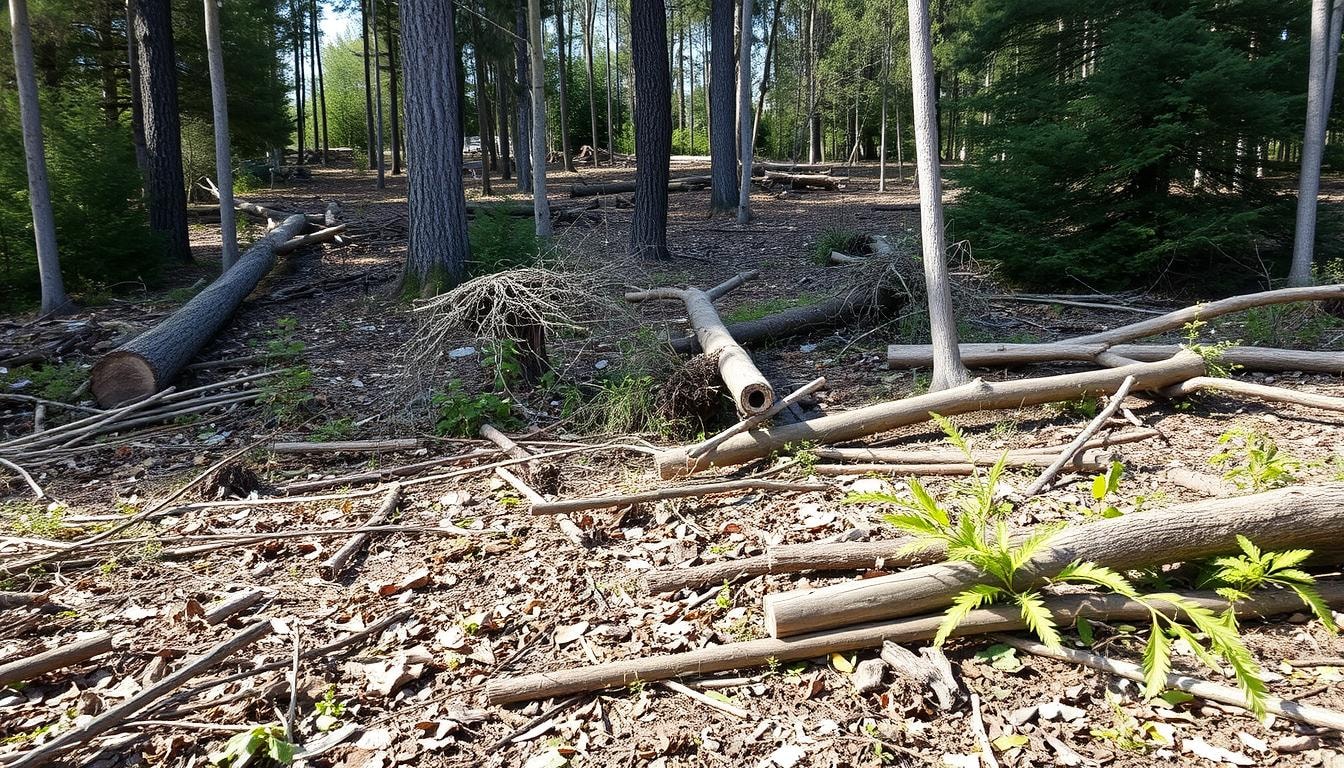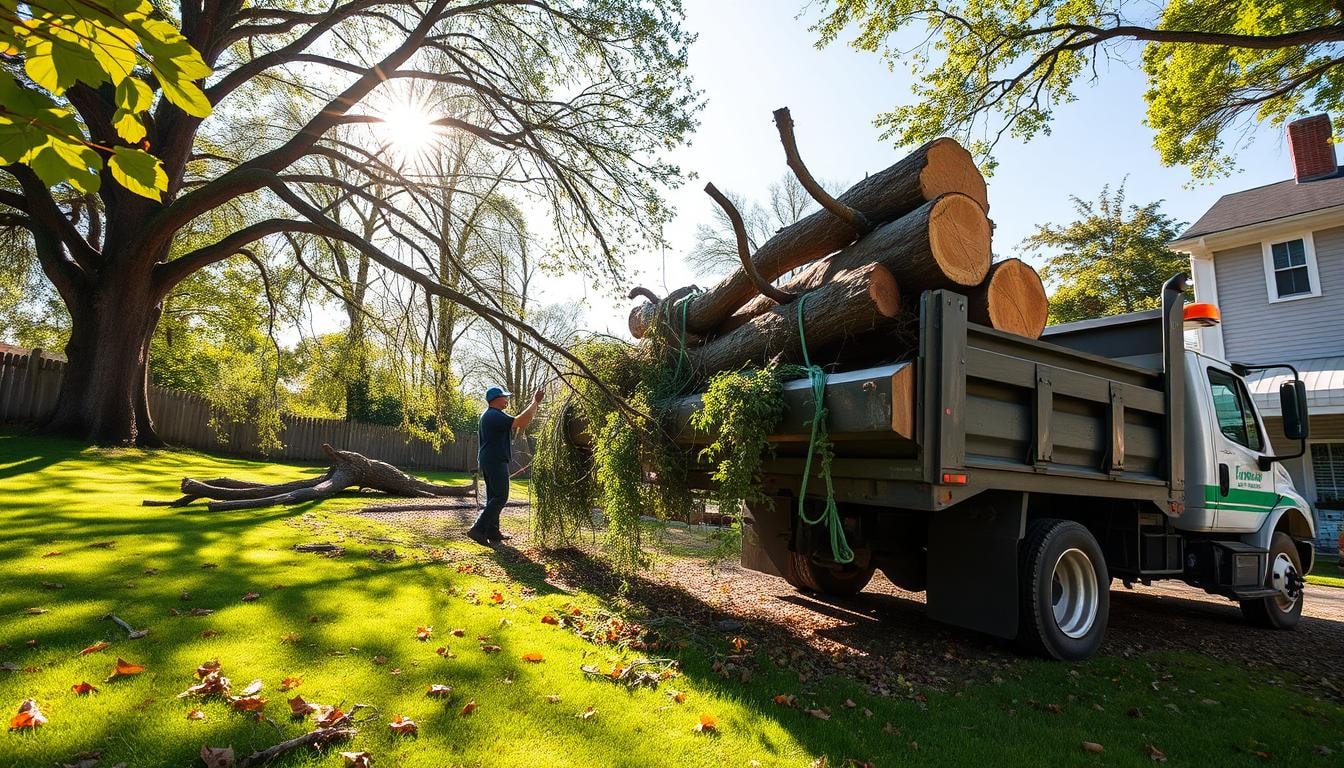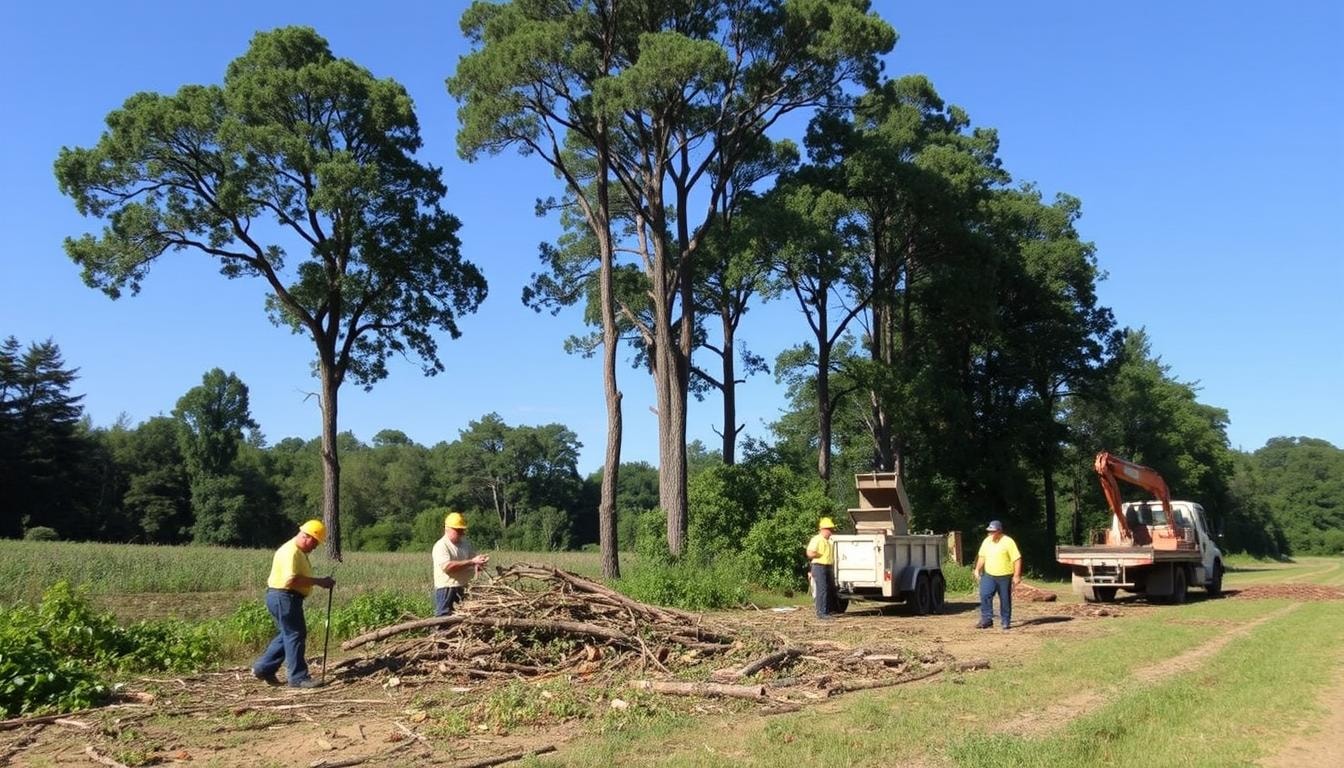Tree Debris Removal Near You
Can’t find what you are looking for?
How It Works
-
Answer a few questions about your home project.
-
Within seconds, get matched with top-rated local pros.
-
Compare quotes and choose the best pro for the job.
Tree Debris Removal In Your Area
How to Find the Best Tree Debris Removal Service

Key Takeaways
- Understand the different types of tree debris and associated removal costs
- Explore professional tree debris removal options, including renting a dumpster
- Learn about DIY solutions for hauling away tree limbs and dropping off at landfills
- Discover the benefits of renting a wood chipper for efficient tree debris management
- Uncover creative ways to repurpose tree debris, such as turning it into mulch or firewood
Understanding Tree Debris Removal
Tree debris includes branches, limbs, stumps, trunks, leaves, and grass clippings. It also covers other organic waste from trees and landscaping. Managing tree debris keeps properties safe and tidy.
Types of Tree Debris
The main types of tree debris include:
- Branches and limbs
- Stumps and trunks
- Leaves and grass clippings
- Brush and wood chips
- Green waste such as yard trimmings
Each type of tree debris has unique traits. They may need different removal and disposal methods. Knowing these differences helps create better tree debris management plans.
Handling tree debris correctly is vital for property safety and looks. Understanding debris types and removal methods prevents hazards. It also helps manage organic waste more effectively.
Professional Tree Debris Removal Options
Managing tree debris requires careful consideration of professional options. Renting a dumpster is a popular choice for convenient debris collection and disposal. Dumpster sizes range from 10 to 40 cubic yards, allowing flexible loading and pickup schedules.
Renting a Dumpster
Tree debris removal costs vary, averaging around $150. Labor costs typically range from $50 to $100 per hour. Stump removal, an additional service, can cost between $80 to $250 per stump.
Several factors influence pricing, including load size, vehicle size, and distance to disposal location. Tipping fees also play a role in determining the overall cost.
Dumpster rental offers on-site debris collection and professional handling. This option saves time and reduces the risk of injuries from DIY removal.
For smaller amounts of debris, DIY solutions may be more cost-effective. These include dropping off at local landfills or transfer stations.
- Dumpster sizes range from 10 to 40 cubic yards
- Rental process typically involves coordination with local waste management
- Costs can be influenced by load size, vehicle size, distance to disposal, and tipping fees
- Offers convenience and safety for debris removal
- DIY options may be more cost-effective for smaller amounts of debris
Hauling Away Tree Limbs

Scheduling a bulky waste pickup or curbside collection is a handy option for tree limb removal. Local waste management departments or private hauling services often provide this service. It’s great for larger volumes of tree debris that won’t fit in standard bins.
Many cities offer curbside pickup for yard waste, including tree limbs and branches. Just place the debris at the curb on collection day. The waste team will handle the tree limb removal and organic waste hauling.
This service is usually part of regular waste fees, making it budget-friendly for homeowners. For bigger loads, bulky waste pickup services are available. These waste management services deal with items too large for standard collection.
Residents can set up a pickup time for haulers to remove tree limbs and other bulky waste. These pro tree limb removal options let homeowners get rid of debris easily. No need to haul it yourself or cram it into regular bins.
DIY Tree Debris Removal Solutions
Homeowners can manage tree debris through several DIY options. Local landfills or transfer stations offer proper disposal or recycling services. Many cities have composting programs to turn organic matter into soil amendments.
You can also store and repurpose wood debris as firewood for personal use. These methods help you handle tree waste responsibly and cost-effectively.
Dropping Off at Landfills or Transfer Stations
Taking tree debris to a landfill or transfer station is a straightforward DIY option. It costs about $30 to $40 per ton, making it budget-friendly.
You might need multiple trips depending on your debris volume. Check local guidelines and fees for disposing of tree waste in your area.
- Locate your nearest landfill or transfer station that accepts tree debris
- Prepare the debris by bundling or bagging it for easier transport
- Be prepared to pay the applicable disposal fees based on the weight or volume of your debris
- Inquire about any special instructions or requirements for dropping off tree waste
This DIY method can save you money compared to professional services. It also ensures responsible disposal of your tree waste.
Renting a Wood Chipper
Renting a wood chipper is smart for dealing with tree debris. These machines turn branches and twigs into useful mulch or compost. This approach reduces hauling needs and promotes sustainable yard waste management.
Wood chipper rentals typically cost $70 to $550 per day. Companies offer daily, weekly, or monthly rates to fit your project needs. Longer-term rentals are often more cost-effective for extended projects.
Consider your project’s size when choosing a wood chipper. Electric models work well for light tasks and are affordable. Gas-powered units handle bigger jobs but cost more.
Watch for extra fees like delivery, pickup, and insurance. These can impact your total rental expense.
Renting a wood chipper helps manage tree debris efficiently. It also creates a valuable resource for your lawn. This method reduces waste and boosts your outdoor spaces’ health and beauty.
Creative Ways to Repurpose Tree Debris
Tree debris offers exciting repurposing options beyond traditional disposal methods. Leftover branches, stumps, and trunks can unlock creative potential. From wildlife habitats to unique furniture, the possibilities are endless.
Transform tree debris into cozy homes for local wildlife. Hollow out logs or stumps for birdhouses or insect hotels. Larger branches can become rustic fencing, offering protection for small animals.
- Build birdhouses and insect hotels from tree debris
- Construct wildlife-friendly fencing and structures
- Incorporate stumps and logs into landscaping features
DIY enthusiasts can use tree debris for various projects. Slice trunks into wood slabs for one-of-a-kind furniture like coffee tables or benches. Smaller branches can be woven into baskets, wreaths, or sculptures.
- Craft furniture from wood slabs and logs
- Weave branches into baskets, wreaths, and sculptures
- Utilize tree debris for unique home decor
Tree debris can be valuable in the garden. Shredded branches and leaves make excellent mulch, retaining moisture and suppressing weeds. Larger stumps and logs can become seating areas, pathways, or planters.
- Use shredded tree debris as mulch for gardens and landscaping
- Incorporate stumps and logs into landscaping features
- Explore creative ways to repurpose tree debris in your yard
Repurposing tree debris reduces waste and creates a sustainable environment. It enhances outdoor spaces and provides shelter for wildlife. Your imagination is the only limit to what you can create.
Choosing the Right Tree Debris Removal Service
Finding a reliable tree debris removal service is crucial. A professional provider can efficiently clear your property of unwanted branches and leaves. Consider these factors when searching for the best option:
- Licensing and Insurance: Look for a licensed and insured tree debris removal service. This ensures they follow regulations and provide liability coverage for accidents.
- Experience and Expertise: Choose a provider with a proven track record. Opt for a company with certified arborists who follow industry best practices.
- Cost Estimates: Get multiple quotes to compare pricing. Be cautious of extremely low offers, as they may indicate poor service.
- Customer Reviews: Check online reviews to gauge customer satisfaction. Look for positive feedback on professionalism, timeliness, and attention to detail.
Communicate your specific needs to ensure a smooth process. Discuss timelines, disposal methods, and any special considerations with the service provider.
By choosing the right company, you’ll ensure safe and effective tree debris removal. This will also help you comply with local regulations.
Preparing for Tree Debris Removal
Preparing your property is key before tree debris removal starts. Create space for a dumpster or removal vehicle. Check for needed permits and HOA guidelines.
Organize tree debris into manageable piles. This will make the removal process smoother and more efficient.
Clear your driveway for easy access to removal equipment. Remove obstacles or vehicles to provide enough space. Ask the removal company about the best driveway setup.
- Check if your location requires any permits for tree debris removal. Local regulations may have specific guidelines, and your HOA may also have additional requirements.
- Review your HOA’s policies regarding tree debris disposal. Some communities have specific instructions on how to handle and organize the debris before removal.
- Organize the tree debris into manageable piles or sections. This can help the removal crew efficiently load and transport the materials. Separate any branches, logs, leaves, or other types of debris to streamline the process.
Good preparation ensures a smooth tree debris removal experience. Follow all guidelines to make the process efficient and hassle-free.
Disposal Methods and Regulations

Proper tree debris disposal requires knowing approved methods and local rules. Options may include landfills, transfer stations, recycling, or composting programs. Check your area’s guidelines to ensure environmental compliance.
Landfills are common for tree debris disposal. However, check local rules for weight or volume limits. Some areas have specific preparation requirements for tree debris.
Transfer stations offer a handy alternative to landfills. They often have areas for yard waste and organic materials. These facilities may provide recycling or composting services.
- Many municipalities offer curbside pickup programs for tree debris, especially during seasonal leaf and branch collection periods.
- Some regions have regulations that prohibit burning of tree debris, so it’s essential to understand and comply with these local guidelines.
- Composting is an environmentally friendly option for disposing of tree debris, as it can be repurposed as nutrient-rich soil amendment.
Following local rules for tree debris disposal is vital. It ensures responsible management and minimal environmental impact. Stay informed and use best practices for your cleanup efforts.
Environmental Impact of Tree Debris Removal
Tree debris removal is vital for a healthy landscape. However, it can affect the environment. Poor disposal can increase emissions and waste organic materials. It’s crucial to think about eco-friendly ways to handle tree debris.
Tree debris removal has a carbon footprint from transport and disposal. Landfill decomposition releases methane, a harmful greenhouse gas. Sustainable disposal options like composting or chipping can reduce the environmental impact.
Composting tree debris creates useful soil for gardens. Chipping can make mulch for landscaping projects. Both methods promote resource conservation and offer ecological benefits.
- Use composting or chipping to lessen tree debris removal’s impact.
- Repurpose tree debris as mulch or soil to promote resource conservation.
- Reduce the carbon footprint of transportation and disposal.
- Boost ecological benefits by using eco-friendly removal practices.
By adopting sustainable methods, we can make tree care more environmentally-friendly. This approach helps protect our landscapes and the planet.
FindPros: Your One-Stop Solution for Efficient Yard Debris Removal
Navigating the complexities of yard waste removal can be daunting, but FindPros is here to make the process seamless. Whether you’re dealing with tree branches, fallen trees, or other yard debris, our network of top-rated local professionals can provide the yard waste removal services you need. Simply answer a few questions about your home project, and we’ll match you with the best-suited pros who will compete for your business, ensuring you get the most competitive pricing.
From tree stump removal to brush pile pickup, our trusted providers will handle all the heavy lifting, allowing you to make an informed decision and enjoy a complete, hassle-free solution for your yard waste disposal needs.
Conclusion
Effective tree debris removal keeps your property safe and tidy. You can choose professional or DIY options based on your needs. Prioritize efficiency, safety, and sustainability for successful tree debris removal.
Professional services offer safety, expertise, and proper disposal methods. They save time, reduce accident risks, and enhance your property’s appeal. Responsible disposal is crucial for environmental stewardship and ecosystem balance.
Managing tree debris is key to property maintenance. Choose between professional or DIY solutions based on your needs and budget. Consider all factors to ensure efficient, effective, and eco-friendly tree debris removal.
Frequently Asked Questions (Tree Debris Removal)
MOST POPULAR CITIES
Browse by State- Alameda
- Costa Mesa
- Laguna Beach
- Orange
- Alhambra
- Culver City
- Lancaster
- Oroville
- Anaheim
- Daly City
- Livermore
- Oxnard
- Antioch
- Davis
- Lodi
- Pacific Grove
- Arcadia
- Downey
- Lompoc
- Palm Springs
- Bakersfield
- El Centro
- Long Beach
- Palmdale
- Barstow
- El Cerrito
- Los Angeles
- Palo Alto
- Belmont
- El Monte
- Malibu
- Pasadena
- Berkeley
- Escondido
- Martinez
- Petaluma
- Beverly Hills
- Eureka
- Marysville
- Pomona
- Brea
- Fairfield
- Menlo Park
- Port Hueneme
- Buena Park
- Fontana
- Merced
- Rancho Cucamonga
- Burbank
- Fremont
- Modesto
- Red Bluff
- Calexico
- Fresno
- Monterey
- Redding
- Calistoga
- Fullerton
- Mountain View
- Redlands
- Carlsbad
- Garden Grove
- Napa
- Redondo Beach
- Carmel
- Glendale
- Needles
- Redwood City
- Chico
- Hayward
- Newport Beach
- Richmond
- Chula Vista
- Hollywood
- Norwalk
- Riverside
- Claremont
- Huntington Beach
- Novato
- Roseville
- Compton
- Indio
- Oakland
- Sacramento
- Concord
- Inglewood
- Oceanside
- Salinas
- Corona
- Irvine
- Ojai
- San Bernardino
- Coronado
- La Habra
- Ontario
- San Clemente